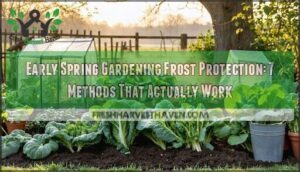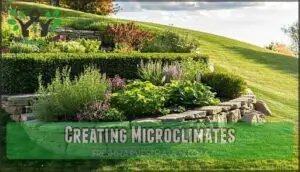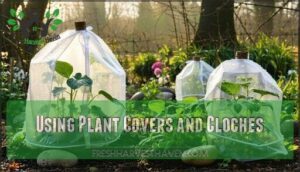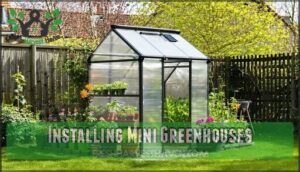This site is supported by our readers. We may earn a commission, at no cost to you, if you purchase through links.

Water-filled containers around plants release heat overnight, creating protective microclimates. Choose frost-tolerant vegetables like kale, spinach, and peas that can handle light frosts.
Start seeds indoors and gradually acclimate seedlings before transplanting. Mulch around plants helps insulate roots, while proper garden bed preparation sets you up for success.
Smart timing and the right protective gear can extend your growing season by weeks, sometimes even months ahead of schedule.
Table Of Contents
- Key Takeaways
- Frost Protection Methods
- Plant Selection Strategies
- Garden Preparation Tips
- Seed Starting Techniques
- Effective Frost Protection Tools
- Frequently Asked Questions (FAQs)
- Do I need to cover plants at 35 degrees?
- What plants need to be covered at 40 degrees?
- At what temperature should I cover my vegetable garden?
- How can I predict unexpected frost events?
- What are the signs of frost damage?
- Can mulching help protect plants from frost?
- What materials should I avoid for frost covers?
- How do I care for frost-damaged plants?
- When should I stop watering before frost?
- How do I protect fruit trees from frost?
- Conclusion
Key Takeaways
- Deploy protective covers before frost hits – Use row covers, cold frames, or cloches when temperatures drop to 32°F or below, securing them properly to trap soil heat and create warming microclimates around your plants.
- Choose frost-tolerant varieties for early planting – You’ll succeed with hardy vegetables like kale, spinach, and broccoli that actually improve in flavor after light frost, while avoiding tender plants like beans and peppers until after your last frost date.
- Create natural heat sources and microclimates – Position water-filled containers near plants to release overnight heat, use south-facing slopes and wind barriers, and add thermal mass like stone walls to naturally extend your growing season.
- Start seeds indoors and time transplants strategically – Begin seed starting 6-8 weeks before your last frost date, gradually harden seedlings, and preheat soil with black plastic covers to give transplants the best chance of survival.
Frost Protection Methods
When temperatures drop unexpectedly in early spring, your tender seedlings and newly planted vegetables face serious damage from ice crystal formation within their tissues.
You’ll need proven frost protection methods that work quickly and effectively to save your garden investment.
Using Row Covers
Row covers act as your garden’s first line of defense against spring’s unpredictable temperature swings. These lightweight row cover materials create protective microclimates that boost temperatures by 2-8°F, giving your frost sensitive plants the vital edge they need to survive cold snaps.
Row covers become your garden’s armor against spring’s surprise attacks, boosting temperatures when it matters most.
Garden fabric shields work like invisible armor, trapping soil heat while allowing 70% light transmission. Heavy-weight frost blankets deliver 6-10°F protection, while standard covers provide 4-5°F buffers. The soil warming effect extends beyond immediate protection—covered areas maintain temperatures 5-10°F higher than exposed ground, cutting germination time in half.
Crop insulation becomes effortless with proper technique:
- Deploy covers before temperature drops, not during cold events
- Secure edges with rocks or stakes to prevent wind damage
- Choose appropriate weight based on expected frost severity
- Remove covers once daytime temperatures stabilize above 50°F
These spring garden frost protection tools transform risky early planting into calculated advantage, letting you start your season weeks ahead of schedule. Using row cover benefits can help extend the growing season and improve crop yields.
Creating Cold Frames
While row covers provide excellent protection, cold frames offer a permanent solution for winter gardening and season extension.
Think of them as mini greenhouses that create protective microclimates around your plants.
Cold Frame Materials and Frame Construction:
- Salvaged Windows: Hunt down old storm windows or glass doors – they’re perfect tops that trap heat effectively while providing garden insulation.
- Clear Plastic Alternative: Use sturdy polycarbonate panels if glass isn’t available for your DIY frames construction project.
Position your cold frames on south-facing slopes for maximum solar gain.
These structures excel at spring gardening protection by creating beneficial microclimates that shield plants like protective blankets.
When building cold frames, consider using kits to simplify construction and guarantee proper frost protection for your most vulnerable plants.
Using pre-made cold frame kits can greatly simplify the process of creating effective frost protection for your garden.
Employing Irrigation
Beyond cold frames, irrigation timing becomes your secret weapon against frost damage.
When temperatures hit 34°F, activate sprinkler systems to release latent heat through continuous water application. This frost prevention technique maintains critical soil moisture while creating protective ice layers around plants.
Proper overnight protection requires running sprinklers until ice melts completely. Effective cold weather methods can substantially reduce frost damage to crops.
| Temperature Trigger | Action Required |
|---|---|
| 34°F | Start irrigation systems |
| 32°F | Maintain continuous water flow |
| Morning thaw | Stop when ice melts |
Smart water protection transforms ordinary sprinklers into frost-fighting champions, safeguarding your garden investment.
Protecting Root Crops
Root crops thrive when temperatures drop, transforming starches into sugars for enhanced flavor.
These frost-sensitive plants need strategic root protection to survive cold snaps while maintaining their sweetness.
Here’s your frost damage prevention strategy:
- Apply thick mulch layers around plants for consistent soil temperature regulation
- Install row covers during unexpected cold fronts for immediate crop insulation
- Select cold hardy plants with proven frost tolerance for your zone
- Ensure proper drainage to prevent waterlogged, vulnerable root systems
- Time harvests strategically before severe weather threatens your crop
Smart root crop selection paired with these frost protection methods keeps your underground treasures safe and sweet.
Plant Selection Strategies
Smart plant selection makes the difference between thriving crops and frost-damaged disappointment.
Choose wisely—hardy plants laugh at frost while tender ones turn to mush overnight.
You’ll want to focus on cold-hardy varieties that can handle temperature swings while avoiding tender plants that’ll turn to mush at the first sign of frost, which is crucial for a successful harvest with thriving crops.
Choosing Hardy Vegetables
Smart vegetable selection forms your first line of defense against unpredictable spring weather.
Choose hardy vegetables like broccoli, kale, and Brussels sprouts that actually improve in flavor after frost tolerant conditions.
These cool season champions handle temperature swings without missing a beat.
Hardy crops give you reliable harvests when tender plants fail, making cold hardy plants the backbone of successful early spring gardens.
Understanding cold hardy varieties is essential for a thriving garden in harsh weather conditions.
Selecting Frost-Tolerant Crops
Once you’ve picked your hardy varieties, you’ll want frost-tolerant crops that actually deliver.
These resilient plants handle temperature swings while keeping your harvest schedule on track.
- Root vegetables like carrots and beets: They’ll sweeten up beautifully after frost hits
- Leafy greens including spinach and kale: These cool season crops actually improve in flavor
- Brassicas such as broccoli and cabbage: Winter gardening champions that laugh at light frosts
Avoiding Tender Plants
The wrong plants at the wrong time can spell disaster for your garden. Frost sensitive plants like beans, sweet corn, peppers, and cucumbers can’t survive temperatures below 32°F, turning black and wilting overnight when caught off guard.
Understanding your plant hardiness zone helps you dodge these costly mistakes. Cold tolerance varies dramatically between species—while hardy vegetables actually improve after light frost, tender plants need consistent warmth to thrive.
Smart garden planning means checking your last frost date before planting frost-sensitive vegetables outdoors. Container gardening offers flexibility, letting you quickly move cold-sensitive plants indoors when temperatures threaten to drop.
Strategic placement matters too. Position frost-prone plants near south-facing walls that absorb heat during the day, creating protective microclimates. These structures can raise surrounding temperatures by several degrees, giving tender plants the edge they need.
Save yourself the heartache—focus on frost-tolerant varieties for early spring planting, then introduce tender plants after your area’s last frost date passes.
Tender Plant Frost Damage Signs Frost Protection Tips Microclimate Benefits
Garden Preparation Tips
Before you can protect your garden from frost, you need to set up the right conditions for success.
Smart garden preparation creates natural defenses against cold temperatures while maximizing your plants’ chances of survival.
Cleaning Garden Beds
Before tackling spring garden frost protection, you’ll need thorough bed preparation to set your plants up for success.
Start by removing fallen leaves, dead stems, and winter debris that harbor pests and diseases. This debris clearance and weed control eliminates competition while improving airflow around frost sensitive plants.
Here’s your garden sanitation checklist:
- Clear all organic matter that could freeze and damage emerging shoots
- Remove weeds that steal nutrients from your precious seedlings
- Sterilize tools between beds to prevent disease spread
Soil removal of compacted areas improves drainage and root health. Clean beds create the foundation for effective gardening in frost conditions, ensuring your early spring gardening efforts aren’t sabotaged by lingering winter problems that compromise spring garden care.
Creating Microclimates
Once you’ve cleaned your garden beds, you can start building natural microclimates that’ll protect your plants like invisible shields. Position raised beds on south facing slopes where they’ll catch maximum sunlight and warm up faster than flat ground.
Create effective wind breaks using hedges, fences, or strategically placed rocks. These barriers trap warm air and shield frost sensitive plants from harsh winds that can drop temperatures by several degrees.
Add thermal mass elements like stone walls or water barrels near your garden. They’ll absorb heat during the day and release it slowly at night, keeping your soil warming longer.
| Microclimate Feature | Temperature Benefit |
|---|---|
| South-facing walls | +2-3°F warmer |
| Wind barriers | +1-2°F protection |
| Thermal mass objects | +1-2°F overnight |
These frost protection methods create pockets of warmth that extend your cold weather gardening season naturally.
Seed Starting Techniques
Getting your seeds started early gives you a huge advantage over frost, but timing and technique matter more than rushing the process.
You’ll want to master indoor seed starting, prep your soil properly, and keep your tools sharp for the season ahead.
Starting Seeds Indoors
Beyond soil prep, seed starting indoors builds your frost protection arsenal. Your seed selection and germination timing determine seedling strength.
- Use sterile potting mix for seed tray preparation success
- Maintain soil temperature at 65-75°F with heat mats
- Provide 14-16 hours of indoor lighting using grow lights
- Plan transplant timing 6-8 weeks before last frost
This approach creates robust seedlings ready for seedling hardening. Strong starts beat Mother Nature’s curveballs every time.
Understanding winter sowing techniques can also enhance your seed starting strategy.
Pruning and Tool Maintenance
Sharp garden shears make clean cuts that heal faster, protecting plants from disease entry points. Well-maintained tools prevent accidents during frost protection work.
Here’s your essential maintenance schedule:
| Tool Type | Maintenance Task | Frequency |
|---|---|---|
| Garden Shears | Blade sharpening | Monthly |
| Hedge Trimming Tools | Handle repair check | Seasonally |
| All Equipment | Oil application | After each use |
Clean pruning techniques start with proper tool sharpening and blade maintenance. Equipment storage in dry conditions prevents rust formation. This is crucial for maintaining the longevity and effectiveness of your gardening tools, ensuring they remain in good condition for frost protection work.
Preheating Soil for Transplanting
Soil temperature acts as your garden’s foundation for success.
Preheat soil using black plastic covers or dark mulch 2-3 weeks before transplanting. This soil warming technique raises temperatures by 5-10°F, creating ideal conditions for transplant timing.
Your frost protection methods start with proper heat retention in garden bedding for stronger early spring gardening.
Effective Frost Protection Tools
You’ll need specialized tools to protect your plants when temperatures drop unexpectedly in early spring.
The right equipment can mean the difference between thriving seedlings and frost-damaged casualties that set your garden back weeks.
Using Plant Covers and Cloches
Plant covers and cloches offer targeted frost protection methods that create warming microclimates around vulnerable plants. These winter protection tools trap radiant heat while maintaining essential airflow for healthy growth.
Cloche Materials range from repurposed plastic bottles to commercial bell jars, providing individualized plant wrapping solutions. Garden Fabric like spun polyester offers breathable protection across larger areas, while Frost Blankets shield entire rows from temperature drops.
Your frost protection strategy should include:
- Install covers before sunset to capture daytime soil warmth
- Secure edges completely using rocks or landscape pins to prevent cold air infiltration
- Remove during sunny days to prevent overheating and excessive humidity buildup
Row Covers made from lightweight materials allow 85% light transmission while raising temperatures by 2-8°F. Frost Covers create protective barriers that can extend your growing season by several weeks, making them invaluable plant covers for spring gardening success. Effective use of frost protection products is vital for maintaining a healthy garden during early spring.
Installing Mini Greenhouses
Mini greenhouses create perfect microclimates for frost protection methods during gardening in early spring.
Position your Mini Greenhouse in sunny spots with adequate Ventilation Systems to prevent overheating.
Choose durable Greenhouse Materials like polycarbonate for Frame Construction.
These compact structures outperform basic plant protection materials, extending your growing season substantially while maintaining essential spring frost protection.
Effective frost protection strategies are vital for sensitive plants in early spring.
Utilizing Cold Frames and Wall-O-Water Protectors
Cold frames and Wall-O-Water protectors offer powerful frost protection for early spring gardening.
These tools create protective microclimates that extend your growing season by 4-6 weeks.
Cold frames trap solar heat using transparent covers, maintaining temperatures 10-20°F warmer than outside air.
Wall-O-Water protectors use water-filled tubes that absorb daytime heat and release it at night, protecting plants from frost damage down to 16°F.
Here’s how to maximize their effectiveness:
- Position cold frames facing south on well-drained slopes for ideal heat capture and cold air drainage
- Install Wall-O-Water rings before planting to pre-warm soil and establish proper microclimate conditions around seedlings
Frequently Asked Questions (FAQs)
Do I need to cover plants at 35 degrees?
Generally, you don’t need to cover plants at 35°F. Most tender plants like tomatoes face damage at 32°F or below, while hardy vegetables tolerate even lower temperatures without protection.
What plants need to be covered at 40 degrees?
Ready to protect your garden treasures?
At 40°F, you’re in the clear—most plants handle this temperature without breaking a sweat.
Only the most tender seedlings or recently transplanted vegetables might need light protection.
At what temperature should I cover my vegetable garden?
Cover your vegetable garden when temperatures drop to 32°F or below.
Tender plants like tomatoes need protection at 32°F, while hardy vegetables like kale can handle light frosts down to 28°F before requiring coverage.
How can I predict unexpected frost events?
Monitor local weather forecasts and temperature trends closely.
Download weather apps with frost alerts.
Watch for clear, calm nights with dropping temperatures.
Check soil thermometers at ground level where frost forms first.
What are the signs of frost damage?
Something’s gone wrong when your plants look wilted despite adequate watering.
Frost damage shows up as blackened, mushy stems and leaves that turn dark brown or black within hours of freezing temperatures.
Can mulching help protect plants from frost?
Mulching provides limited frost protection by insulating soil and retaining ground heat, but it won’t shield plant foliage from freezing temperatures. You’ll need additional covers for effective protection.
What materials should I avoid for frost covers?
Like choosing armor for battle, you’ll want to avoid plastic covers that can damage plants when they touch frozen foliage.
Skip materials that conduct cold or trap moisture against leaves, causing tissue damage.
How do I care for frost-damaged plants?
Remove severely damaged tissue using clean pruning shears, then provide gentle care with light watering and protection from further temperature stress to encourage recovery.
When should I stop watering before frost?
Don’t stop watering before frost – moist soil actually helps protect plants.
Water lightly in late afternoon, then cover plants.
Wet soil retains heat better than dry soil, reducing frost damage risk.
How do I protect fruit trees from frost?
When temperatures drop below 32°F, your fruit trees face serious damage from ice crystals forming inside their tissues.
Cover trees with frost blankets or burlap, wrap trunks with tree guards, and use overhead sprinklers during freezing events to release protective heat.
Conclusion
Successfully implementing early spring gardening frost protection transforms challenging seasonal shifts into manageable garden management.
You’ve learned proven methods that work: row covers, cold frames, water-filled containers, and strategic plant selection.
These techniques create protective microclimates while extending your growing season substantially.
Remember, timing matters most—monitor weather forecasts and act decisively when temperatures threaten vulnerable crops.
With proper preparation and the right tools, you’ll confidently navigate unpredictable spring weather patterns and achieve consistent harvests.










